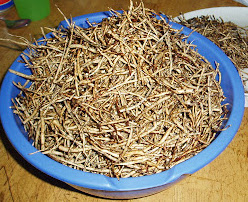 Return to Specific Plants Discussed in Oral History Interviews page
Return to Specific Plants Discussed in Oral History Interviews page
Mouse food (Negaasget in Yup'ik) is the English term used to describe roots collected by Alaska Native people from the buried food caches of small mammals, like lemmings or voles. It is called mouse food because "mice" collect these roots and store them for their winter food supply. The mouse food comes from roots that are one to two inches in length that grow under the tundra, and are picked before the tundra freezes. While the roots may be harvested from a mouse food cache, it is important to leave enough there to sustain the animal who made the cache. In many locations, mouse food is considered critical survival food during starvation times.
Listen to Ted Angasan, Sugpiaq (Alutiiq) from South Naknek, Alaska, talk about mouse food and survival. Or read the transcript (ORAL HISTORY 98-22-03).
Listen to Wassillie Evan and John Philip, Yup'it from Akiak, Alaska, talk about Wassillie becoming a healer and an experience with mouse food. Or read the transcript (ORAL HISTORY 2004-07-23, Part 1.)

